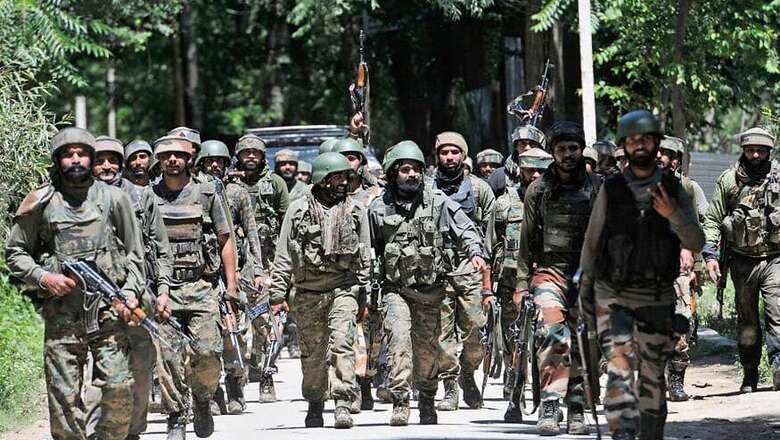
views
More militants were killed in Kashmir’s hinterland this year than in last six years. Almost every other day, one hears news about militants dying in encounters. And some of them like Sabzar Bhat, Abu Dujana, Yaseen Ittoo and Abu Ismail, were the most wanted militants in the Valley.
But how were three forces — local police, Army and CRPF — whose information networks were disrupted in the immediate post-Burhan period, able to get back together to create such a dent in militancy?
News18 spoke to a lot of people in the security establishment, including the Army, police and the CRPF, to understand what goes behind ‘Operation All Out’.
“Right after Burhan Wani was killed in that encounter in July, protests broke across the Valley and most of attention was diverted from counter-insurgency to law and order. For two months after Burhan, all we did was crowd control and focus on improving law and order,” said a senior police officer.
It was during this time that hundreds of youth, 150 according to one estimate, joined militancy. In this period, police and Army began re-establishing their surveillance and human intelligence networks. “Such a spike in the number of youths joining militancy had not been seen in a very long time. It was a big challenge for us,” the police officer added.
But this huge number of youths joining militancy was not just a problem for security forces, it was a big issue for the local militant network also, explained one of the Over Ground Workers (OGWs), who are the back-bone of militant networks in the Valley.
“It was a tough time for us. Earlier, one militant came to us, we could safely give him shelter and take him from one spot to another easily. Suddenly there were 50 militants who wanted shelter. It was never possible to accommodate and safely transport them around in the Valley,” said an OGW. The overwhelming number of untrained youths, who also unwittingly gave leads about their locations through their selfies, became easy target for the security agencies.
OGWs also were the key through which police cracked many militant networks in the Valley, and which led the security forces to many wanted militants. “A militant is like a leaf. You see it from a distance and it seems like a solitary unit. But when you hold it up to the sun, you see these veins supporting it, giving it nutrition. That’s the OGW network. We went after them to go after the militants,” said another IPS officer posted in South Kashmir.
Hundreds of OGWs were arrested across the Valley and many of them were released after interrogation. Some who were let go were followed by the police, and many active militants were thus snuffed out.
“Our intelligence gathering has improved significantly. Earlier we used to get inputs about militants being in a village but cordoning the village and finding out the militants was a tough job. But now we get pin-point intelligence. We can zero down a militant’s presence to four to ten houses which makes it easier to conduct a swift operation,” said IG police, Kashmir, Muneer Khan.
According to a source, 63 militants have been killed in just south Kashmir since July last year — the highest number in the last one decade. Another thing that improved for the security forces was the coordination between the three agencies.
“We didn’t quite fit with each other say two years ago. There were a lot of lapses in our operations. Police had intelligence but not enough resources to fight, Army had resources but not enough intelligence, CRPF had the experience of fighting in places like Bastar. So we sat down together and identified each other’s roles - police would give intelligence, Army would carry out the operations and CRPF would provide the outer cordon,” said a senior CRPF officer.
Forces also changed their strategy to place a lot of emphasis on Cordon and Search Operations (CASO) to exhaust the militants and their informer networks. “Sometimes we would be able to kill a militant, at other times we would not get anything. But these CASOs were still quite necessary as area domination exercises,” the CRPF officer added.
But fighting in hostile conditions wasn’t a cakewalk for the forces either. Many security personnel, around 150, have died in J&K in the last two years. And not all these personnel died in combat.
While security forces were going after militants, the terror networks were also busy in targeting the police. “More than 21 of our policemen died this year not in combat but in hit-and-run operations by the militants. In the big fidayeen attack in Pulwama this August, we lost eight men. It has been quite a difficult year for us also. We have to remain on our toes all the time. The high number of militant kills doesn’t mean that militancy is finished in Kashmir. It is still a tall order,” said a senior police officer.
So with such a high number militants killed this year, how does the next year look for the forces?
“Everything in 2018 will depend on all that we are able to achieve this year. We have been able to kill a lot of high-profile militants. We want to take out as many militant leaders as possible before the winter sets in — militants like Zakir Musa, Riyaz Naikoo, Zeenat ul Islam and Saddam Padder. We are trying to build on this momentum that we have achieved this year, and take it forward the next year,” said IGP Khan.— Read more stories from Kashmir Beyond Cliches series here



















Comments
0 comment